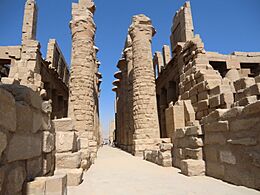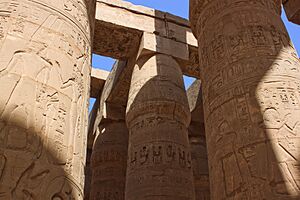Great Hypostyle Hall facts for kids
The Great Hypostyle Hall is an amazing ancient building found inside the Karnak Temple Complex in Egypt. It's part of the Precinct of Amun-Re, which was a huge area dedicated to the god Amun. This hall is one of the most famous and visited ancient Egyptian monuments. It was built around the time of the 19th Egyptian Dynasty, from about 1290 to 1224 BC. The name "hypostyle" means it's a hall with many columns supporting the roof.
Building the Hall
The Great Hypostyle Hall is very big, covering an area of about 5,000 square meters (that's about 53,800 square feet!). Imagine a roof held up by 134 huge columns! These columns are arranged in 16 rows. The two rows in the very middle are taller than the others. They are about 10 meters (33 feet) around and 24 meters (79 feet) tall.
These 134 columns look like papyrus plants. They were meant to represent a swamp where, according to ancient Egyptian beliefs, the god Atum first appeared from the waters of Nun at the beginning of time.
The pharaoh Seti I was the main builder of this hall. He had his name and stories carved into the northern part of the hall. Later, his son, Ramesses II, finished decorating the southern part.
Carvings and Stories
Over time, other pharaohs like Ramesses III, Ramesses IV, and Ramesses VI added their own carvings to the walls and columns. They filled in any empty spaces left by earlier rulers.
The northern side of the hall has carvings that stick out from the wall. These are called "raised reliefs" and were mostly done by Seti I. On the southern side, Ramesses II used a different style where the carvings are cut into the stone, called "sunk reliefs." Sometimes, Ramesses II even added his own name over his father's carvings, making it seem like he built the whole thing! However, most of Seti I's original work in the northern part was left untouched.
The outside walls of the hall show exciting scenes of battles. The northern wall shows Seti I's victories, and the southern wall shows Ramesses II's battles. These carvings weren't just for decoration; they were important records of the wars these kings fought. On another wall, you can even find a record of a Egyptian–Hittite peace treaty that Ramesses II signed in the 21st year of his rule.
In 1899, something surprising happened: eleven of the giant columns in the hall fell down! This happened because groundwater had weakened their foundations. Georges Legrain, a lead archaeologist at the time, oversaw the huge effort to rebuild them. This work was finished in May 1902. Later, more work was needed to make sure the rest of the columns were strong and safe.
See also
- Talatat




